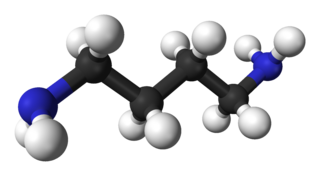This page is based on this
Wikipedia article Text is available under the
CC BY-SA 4.0 license; additional terms may apply.
Images, videos and audio are available under their respective licenses.

Putrescine, is a foul-smelling organic chemical compound NH2(CH2)4NH2 (1,4-diaminobutane or butanediamine) that is related to cadaverine; both are produced by the breakdown of amino acids in living and dead organisms and both are toxic in large doses. The two compounds are largely responsible for the foul odor of putrefying flesh, but also contribute to the odor of such processes as bad breath and bacterial vaginosis. They are also found in semen and some microalgae, together with related molecules like spermine and spermidine.

Weathering is the breaking down of rocks, soil, and minerals as well as wood and artificial materials through contact with the Earth's atmosphere, water, and biological organisms. Weathering occurs in situ, that is, in the same place, with little or no movement, and thus should not be confused with erosion, which involves the movement of rocks and minerals by agents such as water, ice, snow, wind, waves and gravity and then being transported and deposited in other locations.
BESM (БЭСМ) is the name of a series of Soviet mainframe computers built in 1950–60s. The name is an acronym for "Bolshaya Elektronno-Schetnaya Mashina", literally "Large Electronic Computing Machine". The series began as a successor to MESM. MESM was built between 1948 and 1951 and was one of the first electronic computers produced in continental Europe.

BESM-6 was a Soviet electronic computer of the BESM series. It was the first Soviet second-generation computer, based on transistors.

Sergey Alexeyevich Lebedev was a Russian-born Ukrainian Soviet scientist in the fields of electrical engineering and computer science, and designer of the first Soviet computers.

Lebedev Institute of Precision Mechanics and Computer Engineering (IPMCE) is a Russian research institution. It used to be a Soviet Academy of Sciences organization in Soviet times. The institute specializes itself in the development of:

Guardians of Order was a Canadian company founded in 1996 by Mark C. MacKinnon in Guelph, Ontario. The company's business output consisted of role-playing games (RPGs). Their first game is the anime inspired Big Eyes, Small Mouth. In 2006 Guardians of Order ceased operations due to overwhelming debt.

Soil mechanics is a branch of soil physics and applied mechanics that describes the behavior of soils. It differs from fluid mechanics and solid mechanics in the sense that soils consist of a heterogeneous mixture of fluids and particles but soil may also contain organic solids and other matter. Along with rock mechanics, soil mechanics provides the theoretical basis for analysis in geotechnical engineering, a subdiscipline of civil engineering, and engineering geology, a subdiscipline of geology. Soil mechanics is used to analyze the deformations of and flow of fluids within natural and man-made structures that are supported on or made of soil, or structures that are buried in soils. Example applications are building and bridge foundations, retaining walls, dams, and buried pipeline systems. Principles of soil mechanics are also used in related disciplines such as engineering geology, geophysical engineering, coastal engineering, agricultural engineering, hydrology and soil physics.

Spermidine is a polyamine compound found in ribosomes and living tissues, and having various metabolic functions within organisms. It was originally isolated from semen.

Adenosylmethionine decarboxylase is an enzyme that catalyzes the conversion of S-adenosyl methionine to S-adenosylmethioninamine.
Polyamines such as spermidine and spermine are essential for cellular growth under most conditions, being implicated in a large number of cellular processes including DNA, RNA and protein synthesis. S-adenosylmethionine decarboxylase (AdoMetDC) plays an essential regulatory role in the polyamine biosynthetic pathway by generating the n-propylamine residue required for the synthesis of spermidine and spermine from putrescein. Unlike many amino acid decarboxylases AdoMetDC uses a covalently bound pyruvate residue as a cofactor rather than the more common pyridoxal 5'-phosphate. These proteins can be divided into two main groups which show little sequence similarity either to each other, or to other pyruvoyl-dependent amino acid decarboxylases: class I enzymes found in bacteria and archaea, and class II enzymes found in eukaryotes. In both groups the active enzyme is generated by the post-translational autocatalytic cleavage of a precursor protein. This cleavage generates the pyruvate precursor from an internal serine residue and results in the formation of two non-identical subunits termed alpha and beta which form the active enzyme.
Spermine synthase is an enzyme that converts spermidine into spermine. This enzyme catalyses the following chemical reaction

Diamine acetyltransferase 1 is an enzyme that in humans is encoded by the SAT1 gene found on the X chromosome.

Lev Nikolayevich Korolyov was a Russian / Soviet computer scientist, a corresponding member of the USSR Academy of Sciences. He was involved in the development of the first Soviet computers.

Diamine acetyltransferase 2 is an enzyme that in humans is encoded by the SAT2 gene.
SAT2 maintains a key metabolic glutamine/glutamate balance underpinning retrograde signaling by dendritic release of the neurotransmitter glutamate.

S-Adenosylmethioninamine is a substrate that is involved in the biosynthesis of polyamines including spermidine, spermine, and thermospermine.
A polyamine is an organic compound having more than two amino groups. Alkyl polyamines occur naturally but are also synthetic. Alkylpolyamines are colorless, hygroscopic, and water soluble. Near neutral pH, they exist as the ammonium derivatives. Most aromatic polyamines are crystalline solids at room temperature.
Spermine oxidase (EC 1.5.3.16, PAOh1/SMO, AtPAO1, AtPAO4, SMO) is an enzyme with systematic name spermidine:oxygen oxidoreductase (spermidine-forming). This enzyme catalyses the following chemical reaction

Polyamines (PAs) are small, positively charged, organic molecules that are ubiquitous in all living organisms. These are considered as one of the oldest group of substances known in biochemistry. There are three common types of polyamines, putrescine, spermidine, hermospermine according to structure, universal distribution in all cellular compartments, and presumed involvement in physiological activities. Polyamine is found in all cellular compartments and physiological activities due to their simple structures. The function of polyamine is very diverse in that it performs a key macromolecule to cellular membrane. Because of their essential roles in plant, mutation of polyamines can cause critical damage on plants. Furthermore, some polyamines like putrescine inhibit biosynthetic activities in plants. The activity of polyamines can be categorized to some parts due to its signalling and growing activity.















